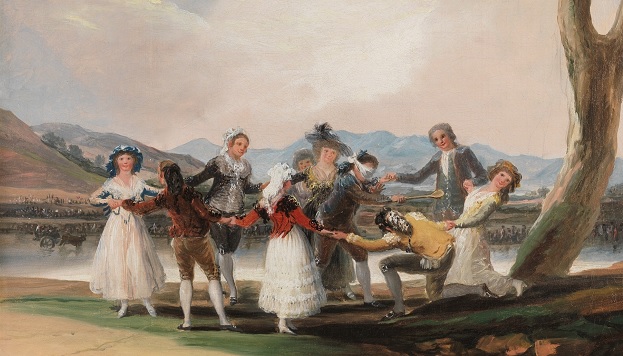The Meadow according to Goya
In 1788, Goya was commissioned to paint a series of cartoons for tapestries to decorate the Infantas’ bedroom at El Pardo Palace. The chosen theme, given the young age of the girls, was popular games. Following the death of Carlos III and the accession to the throne of his son, Carlos IV, the decorative project was interrupted and all that remains of the series are some preparatory sketches, such as those held at the Prado Museum: The Meadow of Saint Isidro, The Hermitage of Saint Isidro on the Saint’s Feast Day or Blind Man's Buff, of which the cartoon also exists.
In this post, we will go on a virtual and artistic journey of the main stage of the series, the famous meadow which is still a meeting place for the people of Madrid today.
The origins of a hermitage on the other side of the River Manzanares dates back to 1528, when Empress Isabel of Portugal, the wife of Carlos V, ordered its construction next to the spring of miraculous water. According to the popular tradition, Saint Isidro made it flow on a very hot day around the 12th century to quench the thirst of his master, Iván de Vargas. It is said that the future Felipe II was cured of a high fever thanks to this fountain which is visited on a pilgrimage by the people of Madrid on 15 May every year. In The Hermitage of Saint Isidro on the Saint’s Feast Day, Goya shows us some majos (working class boys) in the foreground drinking and sitting on the ground and the chapel and a crowd of people can be seen in the background. The presence of the Guardia de Corps leads us to believe that a member of the Royal Household was visiting the place at that moment.

The intermingling of the working classes with the well-off was common on Saint Isidro’s Meadow. In Blind Man's Buff, Goya paints some people dressed in such different ways that it could suggest a certain social balance and harmony: from the woman wearing an elegant hat to the young boys whose hair is gathered up in a net. However, at the end of the 18th century, many boys and girls from Madrid dressed up as working class boys and girls to go on the pilgrimage, although they lived in a palace on Calle de Alcalá. The Duchess of Alba herself was portrayed by the artist in this guise.
Of the tapestries that were going to decorate the bedroom of the Infantas at El Pardo Palace, the most impressive would have been the panoramic view of the Meadow of Saint Isidro, extending over a width of 7 metres. The sketch that is held at the Prado Museum only measures 90.8 cm. However, it is one of Goya’s best known works, perhaps because the silhouette of Madrid is seen bright and happy in the background. From left to right, we can see the Royal Palace, the dip which Calle de Segovia runs down - where the Viaduct, several church towers and the large dome of Saint Francisco El Grande stand today.

The War of Independence would mark a before and after, not only in the history of Spain, but also in the biography of most residents of Madrid and, of course, in that of Goya. He imagined the same meadow that he had painted happy and bright at the age of 42 to be gloomy and dark at the age of 77. His deafness had made the artist more pessimistic, covering the walls of his own home, known as ‘La Quinta del sordo’, with a series of terrible scenes, the so-called Black Paintings.
In one of them we can see a procession of mourners, travelling musicians, crooks, dandies and beggars who are all headed for the Hermitage of Saint Isidro in the Meadow. Who are these present day Madrid residents? Will they ask for a miracle? Or are they victims of a spell? Following the restoration of the monarchy, the liberal ideas that the painter had defended for such a long time, were pursued and, in 1824, Goya left in exile to die shortly afterwards in Bordeaux.
Decades later, Édouard Manet visited the Prado Museum in 1865. Here, he discovered Goya’s paintings, which would be a constant reference for French painters in the second half of the 20th century. To appreciate this influence, which was passed on from one artist to another throughout the 19th century, we can look at a painting by Aureliano Beruete –perhaps the most impressionist of the Spanish painters-, which forms part of the museum’s collection. In this work, we can see Saint Isidro Meadow. The colours are very different: compared with the pinkish tones that appear to belong to a dream in the cartoon sketch, the 1909 painting captures the natural greens and the earth colours of a vibrant and real image. There are also far more buildings on the hill on which Saint Francisco El Grande stands. Anyway, this image of the city , this silhouette of its buildings from Saint Isidro Meadow, is today the skyline that the people of Madrid adore the most.

DON’T MISS
Goya’s Madrid
Discover the Spanish painter’s legacy. All of the works and places that represent the essence of the artist in Madrid.
